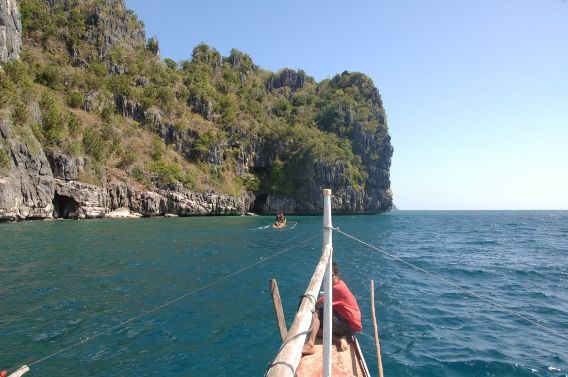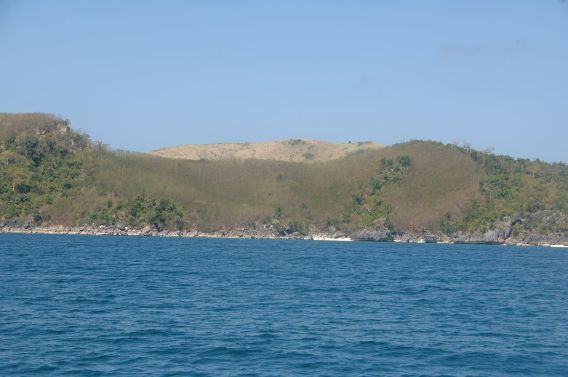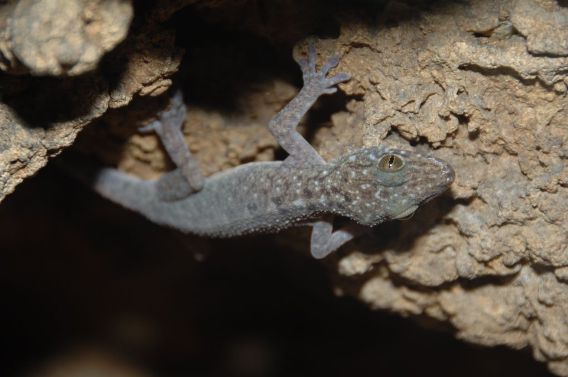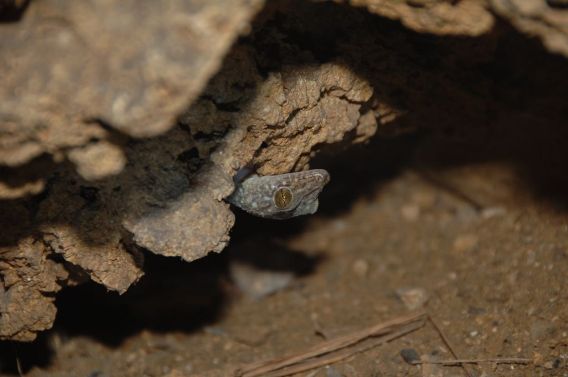Everyone knows the tiger, the panda, the blue whale, but what about the other five to thirty million species estimated to inhabit our Earth? Many of these marvelous, stunning, and rare species have received little attention from the media, conservation groups, and the public. This series is an attempt to give these ‘forgotten species‘ some well-deserved attention.
Travelers to tropical destinations are likely familiar with the gecko. Clinging to walls and ceilings of buildings—sometimes staring down at you from the bedroom ceiling or glancing at you quizzically from the bathroom door—the small adhesive-footed lizard could be aptly described in some tropical areas as ubiquitous. Despite the apparent commonness of some species, geckos are delightful lizards with round wide eyes, a thick gripping tongue, and of course that amazing knack of seemingly defying gravity with specialized toe pads.
But not all geckos are as easily found—or as common—as those hanging out, literally, in a jungle lodge. The Gekko gigante, also known as the Gigante narrow-disked gecko, has been little- noticed by the public. Even scientists know little about the lovely gray-and-blue gecko beyond the fact that it lays its eggs on cool moist cave walls in two Philippine Islands.
In fact, the species is so cryptic that it doesn’t even have the honor of its own Wikipedia page. Meaning that all 172 episodes of the subpar Star Trek: Voyager television show have their very own Wikipedia page, but our living, breathing Gekko gigante does not.
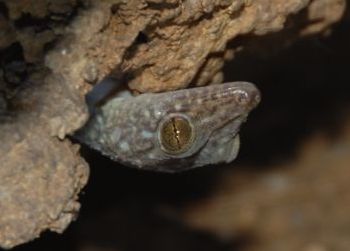 No, this photo is not upside down, the Gekko gigante was caught hanging upside down in its cave habitat. Photo by: Pierre Fidenci. |
Because it lives deep in cave crevices, the Gekko gigante successfully avoided discovery by science for a considerable time. First noted by scientists in 1974, the Gekko gigante has yet to be assessed by the IUCN Red List as to its conservation status. But considering its small range—two islands—and its specialized habitat—caves—it’s likely that the gecko’s population is tiny, according to Pierre Fidenci.
“It is currently found in two small islands (North and South Gigante Islands) and its occupancy is roughly 3-4 km². Both islands are inhabited by roughly 5,000 people mostly fishermen living along the coastline,” explains Fidenci to mongabay.com
Fidenci is the president of Endangered Species International (ESI) and has spent a lot of time in the Philippine seeking little-known species, such as this subterranean gecko. ESI also often focuses on species that have been largely ignored by big conservation groups.
One of a few people to see and photograph the Gekko gigante, Fidenci says of his first encounter: “[the Gekko gigante] was about 15 meters inside a cave […] I thought its head was similar to caiman since I saw it from an unusual angle!”
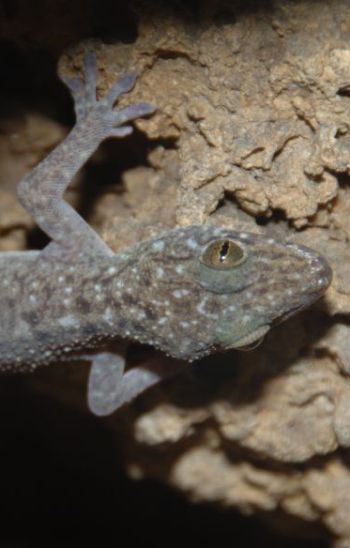 Another view of the Gekko gigante. Photo by: Pierre Fidenci. |
Much has changed on the islands, however, since the cave-dwelling gecko’s discovery in the mid-70s.
“Both islands have already lost significant forest coverage and remaining natural forest is mostly found in area difficult to access like in karst limestone outcrops,” says Fidenci.
An account in Haring Ibon by Rafe M. Brown and Angel C. Alcala describe the forest loss in detail: “What remains is scrubby and stunted vegetation. With the forest gone, conditions on Gigante changed as they have throughout most of the Philippines’ previously forested low elevation areas: water became scarce as the local microclimate turned arid. The absence of shade trees makes the ground hot and dry, and the rainy season erodes the topsoil into the porous limestone beneath.”
But at least for now the endemic gecko seems to have survived the island’s changes, probably due to its preference for caves. But given its tiny range it is unlikely the Gekko gigante is thriving. In fact, threats may come from an unexpected source: tourism.
“Human population growth on both islands and increase in the number of tourists are the main threats to this species in the future,” explains Fidenci. “Any disturbance or change to the caves, rock crevices, or rocky environment could dramatically impact the survival of the gecko. The caves are attractive and can be walked deep making them a destination for tourists. Another threat includes future mining activities that could negatively impact this species.”
Unlike many little-known endangered species, protecting the Gekko gigante probably wouldn’t be difficult or costly. It would just take the will to do so. For example, Fidenci recommends “protecting most caves and restricting their visits”. In addition, he says that “conservation awareness on both islands is an important part of the conservation strategy as few people are aware of their unique biodiversity and the need to protect it. Dynamite fishing and illegal cutting of trees still occur on both islands, so we have a lot of work to do in term of education and awareness.”
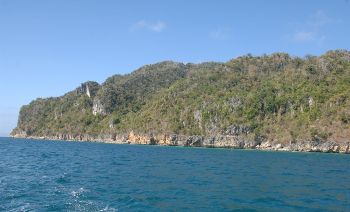 View of South Gigante Island. Photo by: Pierre Fidenci. |
Another step forward would be further the research of the Gekko gigante. Fidenci says research is especially needed on “home range and habitat associations.”
Visitors to either of the Gigante Islands should educate themselves about the islands’ unique biodiversity which also include the Gigante frog and do everything they can to mitigate their impact, according to Fidenci.
“[Tourists] should avoid visiting caves and disturbing rocky environments. Caves are home of endemic and endangered species and they constitute a main physical characteristic of both islands for wildlife. If they cannot resist visiting them, they should do in a very small group along with local officials to avoid any impacts. [The Gekko gigante] should be observed from a distance,” Fidenci explains, adding that “people can also support our group.”
I’ll add one final recommendation to the list: someone should give the Gekko gigante its very own Wikipedia page.
Entrance to cave harboring the Gekko gigante on South Gigante Island. Photo by: Pierre Fidenci.
Approaching South Gigante Island. Photo by: Pierre Fidenci.
The deforested landscape of South Gigante Island. Photo by: Pierre Fidenci.
The Gekko gigante. Photo by: Pierre Fidenci.
The Gekko gigante. Photo by: Pierre Fidenci.
Related articles
Photo: Camouflage expert discovered in Cambodia
(03/25/2010) Researchers have discovered a cryptic species of gecko in the Cardamom Mountains of Cambodia, reports Fauna & Flora International (FFI), a conservation group that operates in the region.
Reptiles underrepresented on the IUCN Red List
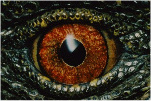
(11/04/2009) Currently there are an estimated nearly 9,000 reptiles in the world, while the International Union for Conservation of Nature (IUCN) Red List has assessed all of the world’s described mammals, birds, and amphibians, reptiles have yet to be fully assessed, leaving herpetologists with an unclear picture of how reptiles are faring in the world. Currently, 1,677 reptiles have been assessed (less than 20 percent of the total number of reptile species known) with 293 added this year.
Photos: new gecko discovered on bizarre and beautiful Socotra island
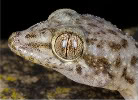
(09/10/2009) Lying in the Indian Ocean half way between Somalia and Yemen, the strange island archipelagos of Socotra offer a bewildering array of life found no where else on Earth. Thirty seven percent of its plant species, ninety percent of its reptiles, and ninety-five percent of its snail species are endemic. Now biologists can add a new species to this list. Italian researchers unraveled the mystery of a gecko named Hemidactylus inintellectus. Inintellectus translates to ‘misunderstood’, since the gecko, which is common on the island, was consistently confused with other species.
(11/08/2008) A previously unknown species of gecko has been discovered in the South Pacific by French scientists, reports the Associated Press.
Two new species of gecko discovered in Australia
(10/31/2008) Two species of gecko have been discovered in the southern deserts of Western Australia and South Australia, report researchers from the Western Australian Museum.
Photo: commonly-kept gecko was thought to be extinct in the wild
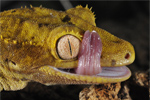
(09/04/2008) The Crested Gecko is endemic to South Province, New Caledonia in the South Pacific. While the species is widely kept in the pet trade, the species was long believed extinct in the wild until it was rediscovered in 1994. It is now known to have three distinct populations and its conservation status is currently being evaluated by the IUCN. Trade in wild-caught individuals is presently banned.
How falling a gecko lands on its feet
(03/17/2008) According to new research the gecko may have the most dynamic tail in the natural world. Two researchers from UC Berkley have discovered that the gecko uses its tail to keep itself from falling off slippery vertical surfaces and when falling to rapidly right itself. So, like a cat, it always lands on four feet.
Gecko-inspired adhesive tape could improve recovery from surgery
(02/18/2008) Researchers are close to developing a biodegradable surgical adhesive based on biomimicry of gecko feet. Geckos are famous for their ability to walk on ceilings and vertical surfaces.
Gecko + mussels = biomimetic underwater adhesive
(07/19/2007) Scientists have developed a new adhesive material based on the properties of mussels and gecko lizard. The researchers say the biomimetic design could produce more durable and longer-lasting bandages, patches, and surgical materials.
Neon green gecko key to preventing Mauritian plant extinction
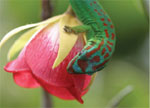
(04/17/2007) A vibrantly colored gecko plays a key role in a highly threatened ecological community in Mauritius reports new research published in American Naturalist. Studying plant-animal interactions in Mauritius, an Indian Ocean island famous for its extinct dodo bird, researchers found that a rare plant, Trochetia blackburniana, benefits from its proximity to Pandanus plants because they house high densities of geckos responsible for pollination. The findings, which unusually identify a lizard as a key pollinator, are significant because they provide “valuable management insights for ongoing conservation efforts to save the highly endangered flora of Mauritius.
Forgotten Species: the marooned pygmy three-toed sloth

(03/16/2010) Many people consider tropical islands mini-paradises: sanctuaries cut-off from the rest of the world. Some species flourish on islands for the same reason. With few predators and a largely consistent environment, once a species has comfortably adapted to its habitat there’s little to do but thrive. That is until something changes: like humans showing up. Changes in confined island ecosystems often have large and rapid impacts, too fast and too big for marooned species to survive.
Forgotten Species: the fiery Luristan Newt
(02/08/2010) The salamander was a mythical creature before it was a real one: the word salamander means a legendary lizard that both survived-in and could extinguish fire. A creature that the Ancient Greeks, including Aristotle, appeared to readily believe in. No one knows how the term salamander transferred from a mythical fire-dwelling monster to the small amphibious animals it applies to today, but I have a theory. Perhaps the sight of salamanders like Luristan newt—charcoal-black and flame-orange—caused people in the seventeenth century to lend the name of myth to the taxa.
Forgotten species: discovering the shimmer of Maathai’s Longleg

(01/13/2010) Few species receive less respect and less conservation attention than insects. This despite the fact that they are some of the most diverse species on the planet andthey provide a number of essential services to humankind, including pollination, pest control, production (for example honey and silk), waster recycling, and indications of habitat health. Scientists are not only unsure just how many species of insects are threatened in world; they are equally uncertain how many insects exist. Currently there are nearly a million insect species described by science, but millions more likely exist. It’s probable that innumerable insect species have vanished before even being catalogued by entomologists.
Forgotten Species: the haunting whistle of the Anjouan scops-owl

(12/03/2009) I know a two-year-old who is already an owl expert. My friends’ daughter, Harper, can identify all of North America’s owls by photos or drawings; even more impressive she can identify them by call. There is one owl call, however, that she may never hear. The Anjouan-scops owl, native to Anjouan island apart of the Comoros island chain, is on the verge of extinction. It is so rare that for over a century it was believed to have already vanished.
Forgotten species: Madagascar’s water-loving mammal, the aquatic tenrec
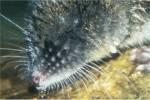
(11/12/2009) There are many adjectives one could attach to the aquatic tenrec: rare, mysterious, elusive, one-of-a-kind, even adorable, though one tries to stray from such value-laden titles since it excludes so many other non-adorable inhabitants of the animal kingdom. This small and, yes, cute insectivore, also known as the web-footed tenrec, lives in Eastern Madagascar where at night it spends the majority of its time swimming and diving in fast-moving streams for insects and tadpoles. It sleeps during the day in small streamside burrows. To date that is about the extent of our knowledge of this species.

